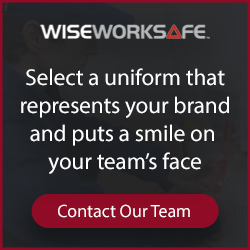Originally published on 9th June 2017
Updated 23rd September 2019
5 Things to Consider When Carrying Out a Rebrand

Rebranding is anything but simple. A brand’s colour can impact customer recognition by as much as 80%. Add this to the fact that 93% of consumers cite visual appearance as a reason they choose to buy from a brand and that branding is used in print, online and on uniforms — and the complexity of a rebrand increases.
WISE Worksafe is committed to providing all our customers with smarter and safer ways to work. We have helped many organisations through the company rebranding process. In this article, we’ve combined our wealth of experience with a selection of studies to provide you with a rebranding process checklist. That way, you will know the key things you need to consider when carrying out a company rebrand.
Why Are You Carrying out a Company Rebrand?
Before considering what your clients expect from your brand and the channels it will appear on, you must decide why you are rebranding your company in the first place. Is it because of a slump in sales? Has there been a change in the competitive landscape? Has your organisation’s values or mission changed since it last reviewed the brand?
Whatever the reasoning, you must confirm the purpose of the rebrand and ensure that all stakeholders fully buy into the concept. By doing so, you will ensure you spend your investment wisely and that there is no confusion over your brand’s purpose in the future.
Consider Your Customers
At the heart of every great brand is a story of passion and a defined mission. While some brands transition over time and revive their stories, it is always good to go back to your roots and ensure your story is embedded in your organisation’s new brand. If you fail to do this, your existing customers may become disconnected.

WISE Worksafe assisted the National Trust through a major rebrand. The trust introduced their now-iconic purple colour to depict the nostalgia and sophistication of their organisation. They placed subtle uses of blue and green in their brand to portray dependability, responsibility and commitment to nature. When combined with the rest of the National Trust palette, these colours continued to represent the National Trust’s values and overriding mission to those already engaged with the trust’s brand — and those it wants to attract in the future.
When you are undergoing your rebrand, you must ask yourself:
-
What are your organisation’s core values and how may these develop in the future?
-
What is your company’s mission statement and how might this evolve?
-
Who are your customers and what kind of brand do they perceive you to be?
It is only through answering these questions that you will have a strong foundation to move onto the following phases of the corporate rebranding process.
Think of Your Employees
As outlined in our article “The Secrets to Selecting a Uniform Your Staff Will Love”, ensuring your employees are aligned with and invested in your brand is pivotal to the success of your business. If your team are not fully on board, customer engagement will suffer, resulting in a fall in sales.
Your employees will have views on how they believe you should represent the brand through its logo, colours, etc. They can also provide a unique point of view into how customers currently perceive your organisation.
So, through staff feedback, you may gain insights into which core values are failing to get through. Giving your workforce input into the process by requesting their feedback will also give them a greater passion for the company they work for and the brand they represent.
Consider All Channels
The days of only considering print and signage when carrying out a rebrand are well behind us — if indeed they ever existed. Since WISE Worksafe began trading in 1977, a vast array of new channels have arisen that play an essential role in your marketing and customer engagement. These include websites, mobile applications, social media and search engines. When combined with print and the corporate clothing your team wear daily, it can seem somewhat overwhelming.
As part of your rebranding process checklist, we suggest you list every channel where your brand appears. Then list a selection of channels you plan to have a presence on within the next two years. Some common channels to consider include:
-
Print
-
Website
-
Social Media
-
Mobile Apps
-
Online Advertising
-
Offline Advertising
-
Premises
-
Staff Uniform
-
Point-of-Sale
-
Events
Once you've outlined all existing and potential channels, you can consider how your new brand's colours and logos will appear on each channel. You may find you develop variations of your logo, such as a simplified version for use where space is limited, or alternative colours for use on different backgrounds. A logo and lengthy strapline may look excellent on the front of a brochure, for example, but a bolder, simpler variation may produce a greater impact on your staff workwear. But remember, you must maintain sufficient consistency to ensure your brand is instantly recognisable across all channels.
Determine a Return on Investment
A rebrand is ultimately a marketing activity — whether your marketing team solely manages it or not. Therefore, as with any advertising campaign or networking event, you should outline a required and expected return on investment before working with a brand agency or ordering new uniforms for your team.
To do this, you must consider every cost associated with your organisation’s rebrand, and view each as an investment, rather than an expense. These could include:
-
A branding consultancy
-
Graphic designers
-
Updated print materials (e.g. business cards, brochures etc.)
-
Revisions to digital channels (e.g. website redesign, social media graphics etc.)
-
Corporate clothing
-
New vehicle signwriting
-
Branded signage
Once you’ve determined the total investment required for your corporate rebranding process, you can calculate the return needed to break even and to gain a profit. Depending on your organisation and the reason for your rebrand, you can then outline what increases in sales, donations etc need to be achieved, and in what time frame.
Are You Ready for a Rebrand?
Have you considered each of the five points on our rebranding process checklist above? Are you ready to proceed with your organisation’s rebrand? If so, we wish you luck and would love to assist in providing high-quality corporate uniform and workwear for your staff, incorporating your revitalised logo and colours.
With our experienced and dedicated account managers, WISE Worksafe not only offers a cost-effective solution but one that requires little of your time. What’s more, we have years of experience working with both large organisations, such as the National Trust and English Heritage, as well as smaller businesses. We’re sure to have a solution for you. Simply call our team on 020 8381 1811 to discuss your project.

 VIEW BASKET
VIEW BASKET



